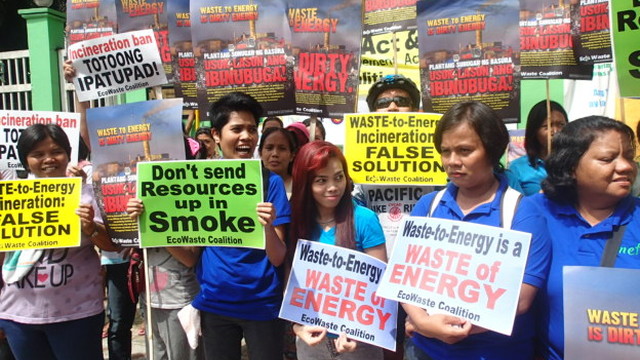SUMMARY
This is AI generated summarization, which may have errors. For context, always refer to the full article.

MANILA, Philippines – Despite protests from environmentalists and concerned citizens, the government will still push through with formulating guidelines for the burning of garbage for conversion into energy.
During a meeting on Tuesday, August 12, the National Solid Waste Management Commission (NSWMC) outvoted a member representing non-governmental organizations who was pushing the commission to abandon the proposed guidelines.
“I served our [complaint] letter but I was outvoted regarding waste-to-energy via incineration,” said Sonia Mendoza, chairman of the Mother Earth Foundation who is also a NSWMC Commissioner representing NGOs.
Groups like the EcoWaste Coalition, Mother Earth Foundation, and Philippine Earth Justice Center believe the creation of guidelines will only encourage more local government units to put up burning facilities that can convert waste to energy.
Burning garbage for this purpose also goes against two major environmental laws: the Clean Air Act (Republic Act 8749) and the Ecological Solid Waste Management Act (Republic Act 9003).
While RA 9003 allows conversion of waste to energy, it prohibits burning as a method to achieve this.
RA 8749 also bans burning because the process leads to “poisonous and toxic” fumes as well as greenhouse gases which cause global warming. The law instead promotes the use of “non-burn” technologies to handle, treat and dispose of garbage.
Taking into account inputs from NGOs, the NSWMC decided to form a “multi-sectoral sub-group” to craft the guidelines.
The guidelines will conform with “all environmental laws and department orders…including emission standards for clean air and waste water,” said NSWMC Executive Director Eligio Ildefonso in a June 2014 letter obtained by Rappler.
He also gave assurances that NGOs would be consulted in the drafting of the guidelines.
Desperate LGUs
The push for waste-to-energy incineration guidelines is coming from LGUs, NSWMC Commissioner Alfred Chan told Rappler.
In fact, some LGUs have already started reaching out to foreign partners to build incineration facilities without the blessing of the commission.
With literally mountains of garbage generated and limited land, you can’t blame LGUs for wanting these facilities, said Chan.
Quezon City, the Metro Manila city that spent the most on garbage disposal in 2013, is particularly aggressive. (READ: QC wastes P250M yearly with flawed garbage program)
The QC Council is seeking for amendments to RA 8749 and RA 9003 to lift the ban on incineration. (READ: QC gov’t: Garbage law too difficult to implement)
According to their own data, Quezon City produces around 438,000 tons of trash every year (equivalent to 146,000 dump trucks). It spent almost P1 billion (US$22.8 million*), the highest among Metro Manila cities, in 2013 just to collect garbage.
Meanwhile, the Payatas landfill the city is using is reaching overcapacity. In fact, it was due for closure on June 30. The QC government is calling on the Department of Environment and Natural Resources (DENR) to allow them to use it for another 6 months.

Waste-to-energy burning technology promises to reduce the need for land fills because instead of taking up space, garbage would be burned right away and converted to energy.
Incineration technology is the “controlled combustion” of waste that recovers heat from garbage thereby producing steam which then goes to turbines, generating electricity.
Countries like the United States, China, Japan, and some countries in Europe already make use of waste-to-energy incineration facilities.
Burning of garbage in a controlled facility can curb dangerous emissions, said Abigail Favis, a professor at the Environmental Science Institute of Ateneo de Manila University.
Use of appropriately high temperatures and emission control devices like filters can bring down emissions to levels compliant with standards issued by the US Environmental Protection Agency.
“But if operated improperly, it can lead to the formation of dioxins and furans – very toxic chemicals,” she told Rappler.
Sophisticated technology to capture toxic chemicals produced by incinerators are very expensive, sometimes taking up half the cost of the incinerator itself, according to renowned waste management expert Salman Zafar.
Even if hi-tech filters or ash are able to capture these toxic chemicals, they will still need to be disposed in special land fills to prevent their entry into ecological systems and human communities.
The technology can only reduce emissions to safe levels and can’t stop the emissions completely.
‘Easy way out’
Burning garbage for energy is the “easy way out” of Metro Manila’s overwhelming garbage problem, said environmentalists.
In fact, it actually encourages cities to generate more trash because waste-to-energy facilities would only be viable if there was a regular flow of garbage to burn.
What’s more, the kind of garbage which will allow the facility to produce the most amount of energy (high in calorific value) are plastics and metals which, coincidentally, emit the most dangerous toxics when burned.
According to a study by Mother Earth Foundation, more than half (52%) of QC garbage is organic waste with very low calorific value.
The most sustainable way for Metro Manila to solve its garbage woes is by simply following the Solid Waste Management Act, said Aileen Lucero of EcoWaste Coalition.
The law requires every LGU to go for zero waste generation by putting up a Materials Recovery Facility (MRF).
MRFs segregate garbage, filtering out what can still be recycled or composted (plastics, paper, rubber, garden waste) from what should go to land fills (hazardous wastes). See how the law is being properly implemented by San Fernando, Pampanga here.
Chan gave assurances that whatever guidelines the commission comes up with will be “science-based.”
“We need to have a scientific evaluation before we jump to conclusions. It’s not a short cut, it’s one of the solutions.” – Rappler.com
*$1 = P44
Add a comment
How does this make you feel?
There are no comments yet. Add your comment to start the conversation.